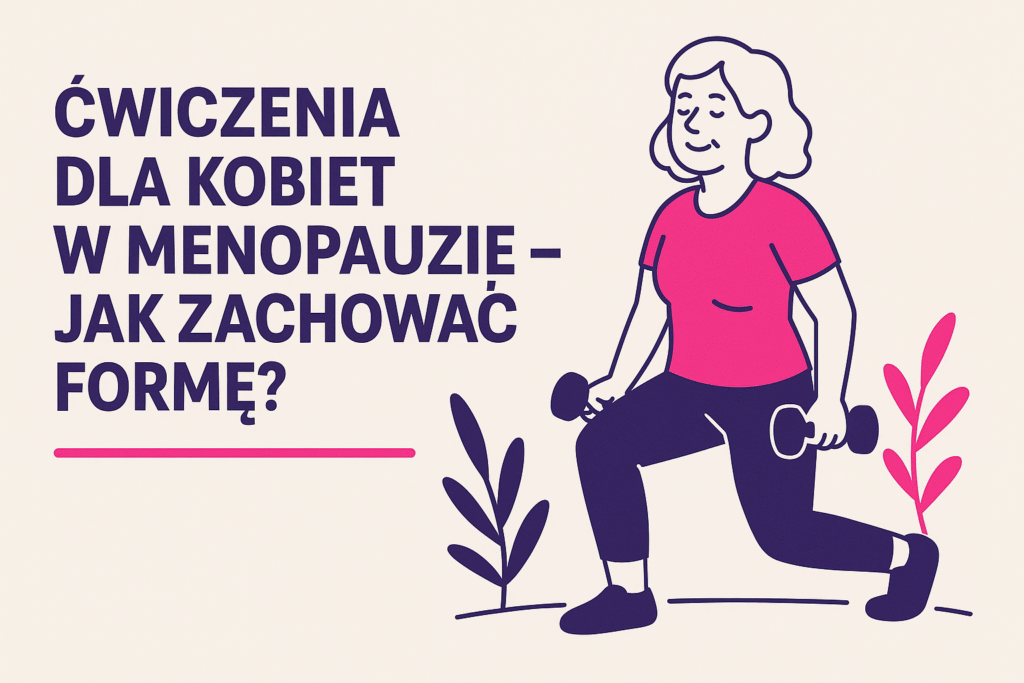Menopause is not only a time of hormonal changes, but also a challenge for the whole body – slowed metabolism, muscle mass loss, sleep problems, mood swings, and decreased bone density. Regular physical activity is one of the most effective tools women can use to combat the effects of menopause, improve well-being, and stay fit for decades to come.
Why exercise during menopause?
Regular physical activity:
- reduces menopause symptoms – hot flashes, insomnia, mood swings¹
- helps with weight control – counteracts menopause-related weight gain²
- increases muscle mass and prevents sarcopenia
- improves bone density and reduces osteoporosis risk³
- lowers the risk of heart disease, diabetes, and hypertension
- strengthens pelvic floor muscles, helping prevent urinary incontinence
- acts as an antidepressant and boosts self-esteem
What types of exercise are best for women over 45?
1. Aerobic (cardio) exercises
Goal: improve cardiovascular endurance, burn fat
Examples: brisk walking, Nordic walking, dancing, swimming, cycling, aqua fitness
Duration: at least 150 minutes per week (e.g. 5 x 30 minutes)⁴
Benefits: easy to implement, improves circulation and metabolism
2. Strength (resistance) training
Goal: build and maintain muscle mass, increase bone density
Examples: exercises with dumbbells, resistance bands, bodyweight (e.g. squats, push-ups, lunges)
Frequency: 2–3 times per week for 30–45 minutes
Benefits: slows down muscle loss and helps prevent osteoporosis⁵
3. Balance and coordination exercises
Goal: prevent falls, improve stability
Examples: yoga, tai chi, Pilates, eyes-closed exercises, stability ball work
Benefits: important for fracture prevention and maintaining independence
4. Stretching exercises
Goal: maintain flexibility, prevent muscle tightness
Examples: dynamic and static stretching after workouts, yoga
Benefits: reduces muscle stiffness and improves joint mobility
5. Pelvic floor exercises (Kegel exercises)
Goal: prevent incontinence and pelvic organ prolapse
Frequency: daily for 5–10 minutes
Benefits: discreet and can be done in any position—even at work
How to start exercising if you’ve been inactive?
- Start with walking – 15 minutes a day and gradually increase the time
- Choose an activity you enjoy – dancing, aqua aerobics, yoga
- Find a workout buddy – it’s easier to stay motivated
- At home – use apps (e.g. Yoga with Adriene, Fitatu, Nike Training Club)
- In a gym – look for classes for women 45+ or “pro age” programs
Sample weekly workout plan for a woman over 45
- Monday: 30-minute walk + 10 minutes stretching
- Tuesday: Strength training at home (legs + glutes, 30 minutes)
- Wednesday: Yoga (60 minutes) or Pilates
- Thursday: Rest or walk
- Friday: Strength training (arms + abs, 30 minutes)
- Saturday: Dance or aqua aerobics (45 minutes)
- Sunday: Full-body stretching + Kegel exercises
What to watch out for?
- Always warm up before workouts (at least 5 minutes) and stretch afterward
- Avoid joint strain – focus on proper form, not force
- If you have osteoporosis – avoid twisting forward bends and jumping (fracture risk)
- In case of chronic illness or pain – consult a doctor or physiotherapist
- Don’t train on an empty stomach – menopause increases the risk of low blood sugar
Summary
Exercise is the cheapest and most accessible way to improve quality of life during menopause. Regular workouts not only strengthen the body but also reduce stress, boost mood, and protect the heart and bones. You don’t need to be an athlete – consistency and choosing the right activity for your needs is enough. After 45, the body needs movement more than ever.
Przypisy
- Elavsky S, McAuley E. Physical activity and quality of life in menopausal women. Health Psychol. 2005.
- Lovejoy JC. The menopause and obesity. Prim Care. 2003.
- Kohrt WM et al. Physical activity and bone health in women. J Bone Miner Res. 2004.
- CDC. Physical Activity Guidelines for Americans, 2nd edition. 2018.
- Howe TE et al. Exercise for preventing and treating osteoporosis in postmenopausal women. Cochrane Database Syst Rev. 2011.

